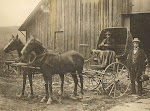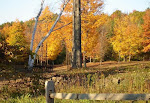It is somewhat shocking how close September is... just a little over a week away! Though I do look forward to autumn, and an end to the heat and humidity, it is always bittersweet to be aware of how quickly time passes. In a few weeks, the lonesome call of Canadian geese heading southward will be filling the air, as well as their V-formations.
The flower gardens have flourished this year, but so have the weeds. It's been a struggle keeping ahead of them, and I've just about lost that battle. There is an abundance of apples and blackberries, yet only a few pears on the trees. The raspberries are coming on again after the first early flush gave up due to the heat and lack of rain. The vegetable garden suffered immensely from chipmunks and red squirrels... I have never seen as many as there's been this year.
Now, the elderberries have begun to ripen, I noted as I watched a bird stealing beak-fulls of them the other morning, so I plucked off enough to make a batch each of Elderberry Syrup and Elderberry Tincture. The tincture will be ready to use in about 6 to 8 weeks... just in time, as flu season starts in October. If the birds don't eat all the berries, I will dehydrate some as they continue to ripen, although I have a quart of dried berries still from last year as back up. (NOTE: If using dried elderberries instead of fresh, use half the given amount.)
To make either, gather the berries when they are dark, deep purple... almost black.Simply twist the whole stem and it should snap the complete umbrel of berries off.
In the photo above, you can see the ripe berries towards the center. Below shows just what you're aiming for.
I find it's easy to strip the elderberries off by grasping the main stem, and using a fork turned upside down around the smaller stems to pull off the berry clumps.
I am making Elderberry Syrup here, and I ended up with roughly a cup of berries. I put these in a pot, added three cups of water, and brought the mixture to a boil. (I often add a 2 inch chunk of fresh ginger root and a 1 inch chunk of fresh echinacea root which I slice into small pieces at this point, too.) Reduce to a simmer for about a half-hour, mashing the berries as the heat softens them, then take off the stove and let sit for about an hour.
Strain through a few layers of cheesecloth, squeezing the cooled berries to release the juice. There will be some pulp and a lot of seeds remaining... I just toss them into the compost pile.
Next, mix in about a half-cup up to one cup of pure, raw honey and mix well. If you desire, you may add a half-cup of brandy, but I did not. I just poured the Elderberry Syrup into an 8 ounce bottle, capped it and stored it in the refrigerator. It should keep for about two months. To use Elderberry Syrup, I take a teaspoonful daily from mid-October through March. If I feel I'm coming down with something, I'll take that dosage two or three times per day.
To make a simple Elderberry Tincture, I put the prepared berries in mason jar, cover with brandy (or vodka), cap the bottle and store in my cool, dark pantry for about 4 to 6 weeks, gently swirling the bottle every few days to mix it. I take a half-teaspoon every day once I've run out of the syrup.










































